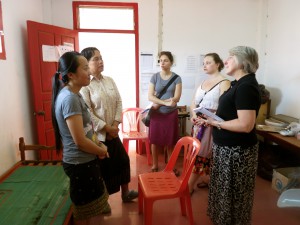
Dr. Cecilia Jevitt, Yale Midwife, writes of her experience at the Nabon Clinic, Lao Ngam District, Salavan Province, Laos.
“The Nabon Clinic covers 14 villages with about 40 mother. It averages about 5 births a month with 4 occurring in February. The roads are unpaved and some mothers on the periphery of the catchment area go to other clinics for birth if those clinics are closer to them. The nurses often see that the women are pregnant when they bring vaccines to the village children. Then, the nurses enroll the women in prenatal care. The mothers come to the clinic every three months for a prenatal check. The women receive prenatal vitamins and iron. They are given a CleanBirth kit at 7 months and instructed to bring it with them when they come for birth or to use it in an emergency if they cannot get to the clinic. If the mother cannot get to the clinic for birth, an older village woman, experienced with birth will help her.
The labor room is like other clinic labor rooms. There is a wooden sleeping platform, an old metal gynecology exam table, and an instrument table with a battery doppler, two pinard fetoscopes, some ring forceps and scissors, and some paper centimeter tapes. There is scale for the baby on the instrument table and a pressure sterilizer on a chair. The sink has hand controls with a small basin. There are no pillows or linen. Family are expected to bring linen, food and drink for the mother.
When we arrived, the nurse had her motor scooter stored in the office. She moved it to an exam room to have access to the office. The room next to the office had a large pallet with a couple hundred dozen eggs stacked in paper cartons. We didn’t ask about the eggs.
There were posters on the outside walls urging polio vaccines as polio has returned to Laos. Posters also warned against malaria and promoted breastfeeding.
The hospital that takes referrals for complicated cases is 11 K (6.8 miles) away from the clinic. In the dry season, it takes one hour to drive. In the rainy season with mud and flooding, it takes 2 hours. The clinic had one labor transfer to the hospital in February, a breech baby that had a vaginal birth at the hospital.
There was one recent death at the clinic. A mother, who was about 45 years old and pregnant with baby #14 came in labor. She thought she was menopausal because her periods had stopped and wasn’t using birth control. She came to the clinic after her membranes had been ruptured for 29 hours. There was an uncomplicated vaginal birth. The newborn could suck breastmilk but was weak and died 9 hours after birth. The nurse thought he was infected. The nurses do not have intravenous antibiotics for administration at the clinic. If the mother seems to be infected, she is given an antibiotic injection and transferred to the hospital for further treatment.
This clinic currently has 5 nurses but one is on maternity leave and one is away at school for new education. Three nurses cover the clinic and live in the building next to the clinic. The clinic is open 24/7. Each night, overnight, 2-3 patients come to be seen. The most frequent cause of visits is childhood diarrhea. About 70% of the nurses’ work is in the community. On Mondays, they go to the villages to administer vaccines. There is a regular schedule of village visits. There are regular district health meetings and trainings to attend. These plus the village visits and nurses on leave, generally leave only nurse staffing the clinic at a time. The nurses write a monthly summary work report during the last week of the month that is sent to the district offices.
All nurses and physicians are employed by the Ministry of Health. They receive a three month postpartum leave for vaginal births and a four month leave for cesarean births.
Birth control pills and the shot (depoprovera) are easily available at the clinic and are administered by the nurses. No doctor’s exam or orders are required. A hundred women came for birth control services in February 2016. Most women come to the clinic with their husbands and have the agreement of their husbands to use birth control.”
Leave a Reply